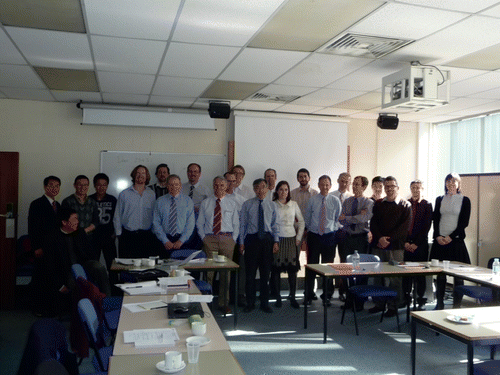The Workshop on Rail Corrugation and Roughness Growth Modelling was held on the 14th and 15th of April 2010 at Manchester Metropolitan University. 23 delegates from eight countries participated in this two-day workshop and 13 oral presentations were made, five of which have been selected for inclusion in this special issue of Vehicle System Dynamics. Although a significant amount of research has been carried out over many years into the rail corrugation problem, the understanding of the initiation and growth of this phenomenon remains insufficient and it still attracts interest worldwide. The workshop brought together key active researchers in this field to review the recent advances in modelling rail corrugation and roughness growth and to exchange their experiences.\medskip
Although theoretical modelling has been important in recent years and has led to the development of several tools this must be informed by observations and measurements to be valid. For this reason a session dedicated to practical experience was organised at the beginning of the workshop and included four presentations from different countries. This included observations of rail roughness development obtained from the recent roughness measurement program being implemented in Sweden, experiences from many years combating corrugations using top of rail friction control technique in North America and a review of the current status of the corrugation problem in railways in Japan.\medskip
The modelling developments presented at the workshop covered various aspects of the corrugation and roughness problems including dynamics, contact mechanics, friction and plastic deformations. Torstensson presented a simulation model for short-pitch corrugation in curves by including low-frequency multi-body dynamics and high-frequency structural dynamics and he also discussed the effects due to falling friction coeffcient on the corrugation from simulation results. Oyarzabal presented modelling results focused on the effects of different track forms including ballasted and slab track while the model presented by Baeza considered the effect of wheelset rotation and his results suggested a newly identified wavelength-fixing mechansim for corrugation initiation.\medskip
Using more accurate and detailed wheel/rail contact models, in particular three-dimensional geometry and non-steady behaviour, and more realistic representation of friction have become recent important advances in corrugation modelling. Non-steady contact mechanics and its effect in modelling corrugation were discussed by several presenters. Xie presented the results of a collaboration between teams at the Rail Technology Unit at MMU and Tongji University, investigating the nonlinearity of the non-steady contact mechanics. This research shows the strong non-linearity due to transient contact geometry variations caused by corrugation and outlined the possibility of finding a linear representation for non-steady contact mechanics. A varying friction coefficient also requires a non-steady contact model and inclusion of a velocity-dependent friction coefficient in the modelling was discussed by Thompson who presented a roughness growth model using a 2D non-steady model which considers this effect. Other papers presented at the workshop covered developments in wheel/rail contact modelling including a generic proposal for heuristic inclusion of inelastic surface displacement in wear simulations and the inclusion of plastic deformation induced rail corrugation.\medskip
A general discussion session was held at the end of the workshop and many interesting open questions were raised and debated. For example: do we need to model plastic deformation? How important are the non-Hertzian and non-steady effects? What is the effect of changing friction coefficient with velocity on corrugation growth? How much are model results influenced by numerical methods? In the end, the central question is perhaps: how well do the current models represent reality? With these many unanswered questions the workshop concluded that further research was fully justified and that this field should still attract the interests of both industry and academia.\medskip
As organisers of the workshop we would like to thank the journal of Vehicle System Dynamics for giving the opportunity to publish the selected five papers from this workshop in this special issue. We would also like to express our appreciation for the enthusiasm shown by all the delegates who participated in the workshop in particular those delegates who had extremely difficult journeys home after the workshop due to the eruption of the Eyjafjallajökull volcano and the grounding of almost all European flights for eight days. We salute your tenacity in finding alternative means of transport!
